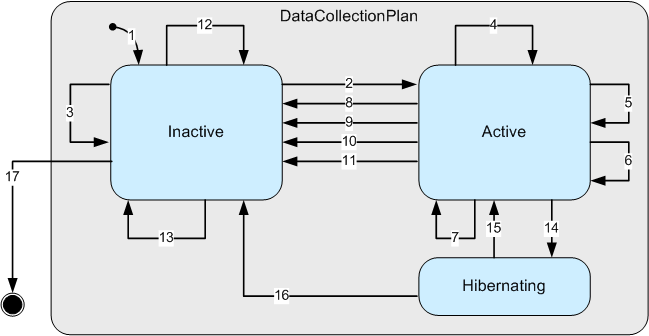SEMI E134
Specification for Data Collection Management
The SEMI Equipment Data Acquisition (EDA), also known as Interface A, standards are a collection of SEMI standards to improve and facilitate communication between IC Maker’s data gathering software applications and the factory Equipment. The E134 standard defines several methods for Interface A Clients to acquire the data described by the E125 information. A client can request data ad-hoc where the requested set of data is returned immediately. Typically, however, the client will define Data Collection Plans (DCP) to configure the desired data gathering. Once DCP are activated, the Equipment continuously sends fire-and-forget Data Collection Reports (DCR) as the data becomes available. In order to optimize data transmission efficiency, clients can enable the optional buffering so that the DCR are buffered at the Equipment and transmitted periodically at the end of each buffering interval. If the ACL allows, clients can activate DCP defined by other clients. E134 also defines how to manage Data Collection Plans when either the Equipment or client shuts down and restarts so the data collection setup can be persisted. SEMI Standard E134.1 Provisional Specification for SOAP Binding of Data Collection Management (DCM) maps the E134 standard into a specific SOAP/XML implementation.
- E134 Data Collection Plan State Model
- E134 Data Collection Plan Traces, Events, and Exceptions
- E134 Data Collection Manager
- E134 DCP Consumer Interface
- Other Major EDA Standards
Download the complete Cimetrix white paper on the SEMI EDA Standards.
SEMI E134 Data Collection Plan (DCP) State Model

E134 Data Collection Plan Traces, Events, and Exceptions
A Data Collection Plan can include any number and combination of Traces, Events, and Exceptions to report when the DCP is activated.
- Traces Traces provide a convenient mechanism for continuously or intermittently polling data at a constant rate. A Trace definition includes a data gathering frequency, a set of E125 data to collect, a start condition, and a stop condition. This configures the Equipment to poll the data at the specified frequency and send it to the client. The optional start and stop conditions, an event or exception, determine when the data collection begins and ends. Otherwise, the Trace data collection begins as soon as it is activated and ends when deactivated or the specified number of reports are gathered and sent.
- Events Events provide a convenient mechanism to receive notification when something important happens and optionally gather any desired data. An E125 state machine transition triggers an event. In the DCP, the client chooses E125 Parameters to include in the Event's DCR. Each time the Event occurs thereafter, a DCR is gathered and sent.
- Exceptions Exceptions notify the client when errors, warnings, or alarms occur on the Equipment. The Exception report includes data, but the data is fixed by the Equipment Supplier in the Equipment Model. Clients cannot select the attached Parameters like with Events.
Traces, Events, and Exceptions that are not listed in activated Data Collection Plans are not sent to any clients. Therefore, the Equipment Supplier determines how much data is available, but the clients determine how much data is actually gathered and reported. Bandwidth requirements depend on the number of clients, the number of activated DCP, the number of Events, Exceptions, and Traces in each DCP, the number of parameters defined for each Event and Trace, the frequency of activated Events and Exceptions, and the frequency of Trace data collection. Therefore the Interface A bandwidth requirements are difficult to determine. Clients can potentially submit enough data collection requests to overload the Equipment's computer and affect the Equipment's throughput. Therefore E134 defines a Performance Status method to notify consumers of an overload condition and allows the Equipment to take appropriate action like disabling certain DCPs or all of the data collection.
E134 Data Collection Manager
E134 defines the DataCollectionManager interface which includes the following client-initiated operations. The equipment must implement this interface.
| Operation | Description |
|---|---|
| DefinePlan | Submit a Data Collection Plan. This includes a set of trace requests, event requests and/or exception requests |
| GetDefinedPlanIds | Request a list of all Data Collection Plan IDs |
| GetPlanDefinition | Retrieve the definition of a Data Collection Plan |
| ActivatePlan | Activate the defined DCP |
| GetActivePlanIds | Request a list of all activated DCP IDs |
| DeactivatePlan | Deactivate the DCP |
| DeletePlan | Delete a DCP |
| GetParameterValues | Ad-hoc request to retrieve the current values of one or more E125 parameters |
| GetObjTypeInstanceIds | Request a current list of unique instance IDs for one or more E39 ObjTypes |
| GetCurrentPerformanceStatus | Retrieve the current Equipment performance status |
E134 DCP Consumer Interface
E134 also defines the DCPConsumer interface which includes the following equipment-initiated, Fire-and-Forget operations. Each client must implement this interface.
| Operation | Description |
|---|---|
| NewData | Data Collection Report from an active DCP. This includes trace, event and/or exception data |
| PerformanceWarning | The Equipment detected performance degradation |
| PerformanceRestored | The Equipment has detected a return to normal conditions |
| DCPDeactivation | Notification that an active DCP for that consumer is deactivated |
| DCPHibernation | Notification when one or more persisted DCP are put into the hibernation state as part of Equipment shutdown |
Other Major SEMI EDA Standards
- E120 Specification for the Common Equipment Model (CEM)
- E125 Specification for Equipment Self Description (EqSD)
- E132 Specification for Equipment Client Authentication and Authorization
Download the complete Cimetrix white paper on the SEMI EDA Standards.


